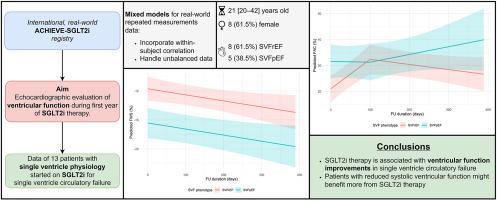钠-葡萄糖共转运蛋白2抑制剂对单心室循环衰竭的超声心动图影响
IF 1.2
Q4 CARDIAC & CARDIOVASCULAR SYSTEMS
International journal of cardiology. Congenital heart disease
Pub Date : 2025-06-21
DOI:10.1016/j.ijcchd.2025.100603
引用次数: 0
摘要
背景:单心室患者发生循环衰竭的风险很高。药物治疗的证据有限。本研究评估了单心室衰竭(SVF)患者在钠-葡萄糖共转运蛋白2抑制剂(SGLT2i)治疗期间心室功能的超声心动图变化。方法选取SGLT2i治疗前6个月内接受基线经胸超声心动图检查的ssvf患者,并在随访12个月内进行至少一次超声心动图检查。采用混合模型评价收缩功能中度降低(SVFrEF)和≤轻度降低(SVFpEF)的SVF患者心室功能的纵向变化和差异。结果纳入13例患者。中位年龄为21岁[20-42]岁,女性8例(61.5%),Fontan循环10例(76.9%),SGLT2i发病时SVFrEF 8例(61.5%),SVFpEF 5例(38.5%)。平均随访7.6±3.3个月。所有患者在前100天收缩末期面积均显著减少(- 1.6 cm2 /月,p = 0.007)。SVFrEF患者的部分面积变化在前100天得到改善(每月3.5%,p <;0.001),而SVFpEF患者保持稳定。所有患者的游离壁应变均有显著改善(- 0.3% -点/月,p = 0.036),但整体纵向应变无显著改善(p = 0.087)。等体积加速度在前100天也有所改善(每月0.5 m/s2, p = 0.010)。结论在SGLT2i治疗SVF患者的第一年,可观察到心室功能改善的心电图信号。本文章由计算机程序翻译,如有差异,请以英文原文为准。

Echocardiographic effects of sodium-glucose cotransporter 2 inhibitors in single ventricle circulatory failure
Background
Single ventricle patients are at high risk of developing circulatory failure. There is limited evidence for pharmacological treatment. This study assessed the echocardiographic changes in ventricular function during sodium-glucose cotransporter 2 inhibitor (SGLT2i) therapy in patients with single ventricle failure (SVF).
Methods
SVF patients with a baseline transthoracic echocardiogram within six months before starting SGLT2i and at least one echocardiographic examination within twelve months follow-up were included from a real-world international registry of adult congenital heart disease patients on SGLT2i. Mixed models were used to evaluate longitudinal changes in ventricular function and differences between patients with SVF with ≥ moderately reduced systolic function (SVFrEF) and with ≤ mildly reduced function (SVFpEF).
Results
Thirteen patients were included. The median age was 21 [20–42] years, 8 (61.5 %) were female, 10 (76.9 %) had a Fontan circulation, 8 (61.5 %) had SVFrEF, and 5 (38.5 %) SVFpEF at the start of SGLT2i. The mean follow-up was 7.6 ± 3.3 months. End-systolic area decreased significantly in all patients (−1.6 cm2 per month, p = 0.007) in the first 100 days. Fractional area change improved in the first 100 days in SVFrEF patients (3.5 %-point per month, p < 0.001), while SVFpEF patients remained stable. There was a significant improvement in the free wall strain in all patients (−0.3 %-point per month, p = 0.036) but not in global longitudinal strain (p = 0.087). Isovolumic acceleration also improved in the first 100 days (0.5 m/s2 per month, p = 0.010).
Conclusions
Echocardiographic signals of improved ventricular function were observed in the first year of SGLT2i therapy in patients with SVF.
求助全文
通过发布文献求助,成功后即可免费获取论文全文。
去求助
来源期刊

International journal of cardiology. Congenital heart disease
Cardiology and Cardiovascular Medicine
自引率
0.00%
发文量
0
审稿时长
83 days
 求助内容:
求助内容: 应助结果提醒方式:
应助结果提醒方式:


